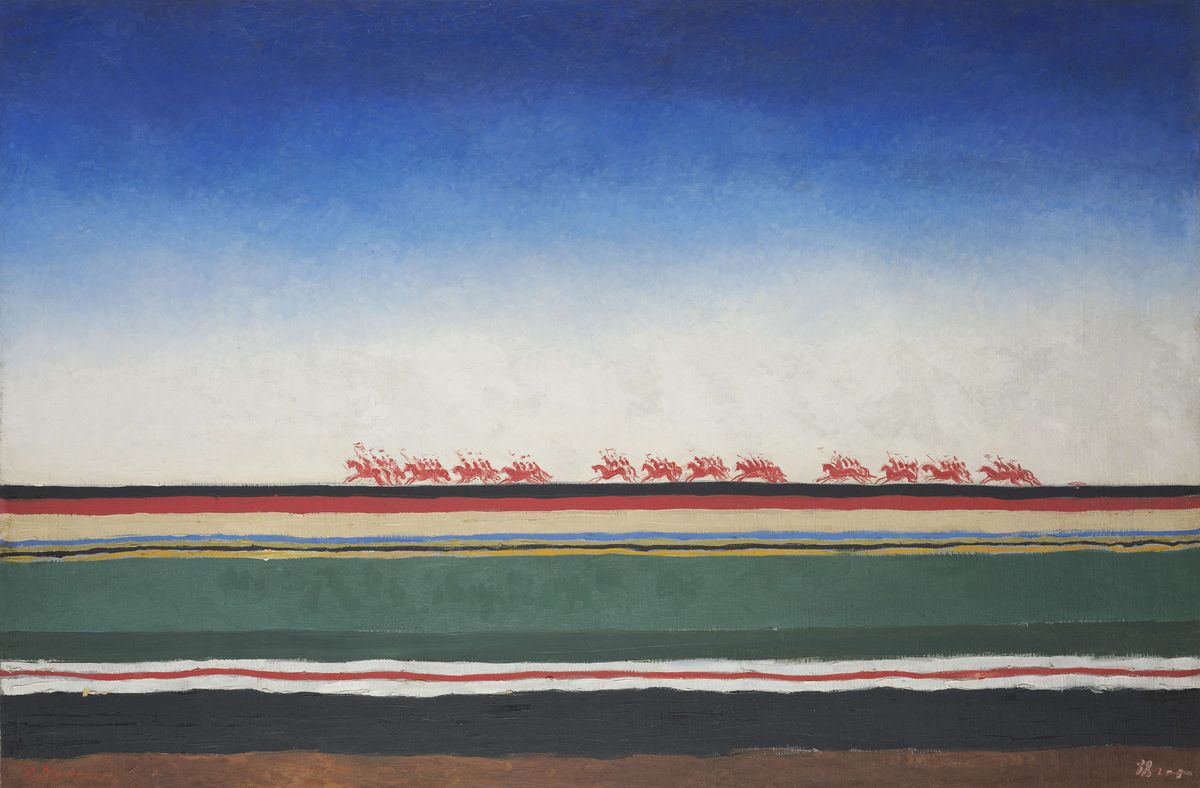


Изобразительные символы Малевича в этой картине можно трактовать по-разному — как напоминание о рыжем апокалипсическом всаднике или как новый знак «мировой революции». Картины военной жизни в отечественном искусстве XVI–XX веков. СПб, 2022. С. 152
Неоднозначность восприятия образов поздних произведений Малевича скрыта в глубинах символики цвета и в его универсальных композиционных схемах. В «Красной коннице» противопоставлены незыблемость, бесстрастность необъятного пространства и хрупкость красных всадников. Что это — напоминание о рыжем апокалипсическом всаднике или — новый символ неотвратимости «мировой революции»? Русский музей. От иконы до современности. СПб. 2015. С. 340.
Долгое время картина была единственной работой опального художника, признанной официальной историей советского искусства. Этому способствовало ее правоверное название, звучавшее, казалось бы в унисон с общепринятым восхвалением революции и Красной армии. Малевич преднамеренно закрепил этот пласт толкований датой «1918 год» в правом углу холста и в надписи на обороте: «Скачет красная конница из октябрьской столицы, на защиту советской границы».
Живописец, график, художник театра, теоретик, педагог.
Родился в Киеве. Учился в Московском училище живописи, ваяния и зодчества (1904—1905) и студии Ф. И. Рерберга в Москве (1905–1910). Участвовал в выставках «Бубновый валет» (1910) и «Ослиный хвост» (1912). В 1910-х оформлял книги футуристов, принимал участие в постановке первой футуристической оперы "Победа над солнцем" (1913). Участвовал в организации общества «Супремус» (лат. — наивысший) и одноименного журнала (1916–1917). Был членом общества "Бубновый валет" (1911). В 1918 работал в Отделе ИЗО Наркомпроса. Преподавал в Государственных средних художественных мастерских в Москве (1918), директор Витебского художественно-практического института (1919–1922). В 1920 основал группу УНОВИС («Утвердители нового искусства»). Директор и профессор Государственного института художественной культуры в Ленинграде (1923–1927).
В 1927 совершил поездку в Варшаву и Берлин. В 1929–1930 преподавал в Киевском художественном институте. В 1932–1933 руководил экспериментальной лабораторией в Русском музее. Автор пейзажей, жанровых сцен, портретов, кубистических и беспредметных композиций, пространственных структур — «архитектонов» и «планит». Работал в области декоративно-прикладного искусства. Написал брошюры «От кубизма и футуризма к супрематизму. Новый живописный реализм» (1915), «Супрематизм» (1920), «Беспредметный мир» (1927) и другие теоретические исследования и статьи. Крупнейший представитель русского авангарда, основоположник теории супрематизма

The key to perceiving the images of Malevich’s later works lies in the depths of the symbolism of colour and his universal compositional schemes. Red Cavalry contrasts the stability of the endless space and the fragility of the red riders. What is this? A hint at the horsemen of the apocalypse or a new symbol of the inevitability of world revolution? Russian Museum: From Icons to the Modern Times. Palace Editions, St Petersburg, 2015. P. 344.
For many years, this artwork, painted in 1932, was considered Malevich’s only contribution to the official history of Soviet art, in light of the fact that the artist had fallen out of favor. It was only permitted into the pantheon of Soviet art due to its title, which appears to eulogize the Russian Revolution and the Red Army. Malevich intentionally dated this painting 1918, in the bottom right-hand corner of the canvas, and on the back he wrote: «From the capital of the October Revolution, the Red Cavalry rides to defend the Soviet frontier».
Despite these grand words, this painting is in fact one of the most desolate and tragic works that Malevich produced during this final stage of his artistic career.
In the composition of this extraordinary artwork we can see a reflection of Malevich’s thoughts on his contemporary reality. In the artist’s own words: «Some leaders invite you to contemplate a spiritual existence, while others incite you to accumulate material goods. And so, their faithful followers begin to march… The flags are changed as frequently as dishcloths, but it is all in vain: our feet remain sweaty, our fingers are still chafed and blistered. The energy of human movement, in the hope of gaining something, is reminiscent of the madmen who rush headlong towards the horizon because they believe they have found the ends of the earth, forgetting that they are already standing on the horizon and do not need to run anywhere».
In this painting, the revolutionary horsemen, whipped by an unseen force and almost lost in the empty, eternal space, race across the land under a host of red flags. The small red silhouettes almost melt away between the Suprematist bands of pure color. Their movement is frantic, useless and absurd, as their journey is endless and the sky and the earth are indifferent to the coming and going of human beings. Ultimately, the Promised Land has never, and will never, exist.
Painter, graphic artist, writer on art, portraitist, landscapist, abstractionist. Studied at the Kiev School of Art (1895-1896) and Fyodor Roehrberg's studio in Moscow (1906-1910). Contributed to exhibitions (from 1905). Contributed to the exhibitions of the Moscow Fellowship of Artists (from 1907), Donkey's Tail (1912), Target (1913), Der Blaue Reiter (1912), Salon des Independants (1914), Tramcar V. First Futurist Exhibition (1915) and 0,10. Last Futurist Exhibition (1915-1916). Designed the sets and costumes for the Futurist opera "Victory Over the Sun" (1913). Member of the Union of Youth (1910) and Jack of Diamonds (1910, 1916). Founded the AFFIRMES OF THE NEW ARTgroup (1920). Worked for Department of An People's Commissariat of Education (1918-1919). Director of the Museum/Institute of Artistic Culture in Petrograd/Leningrad (1923-1926).



